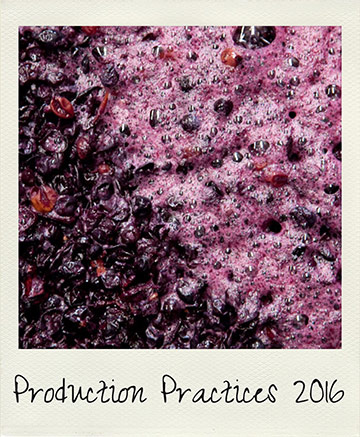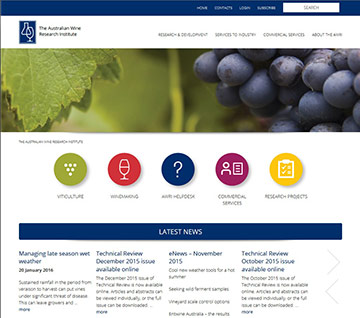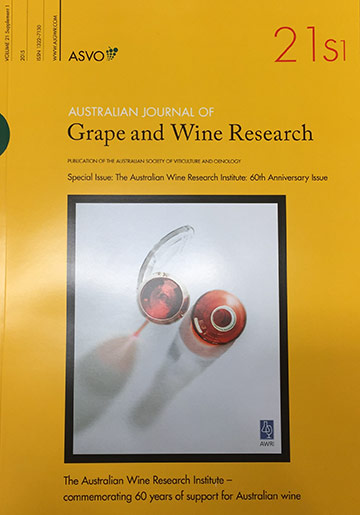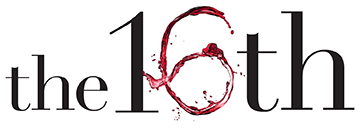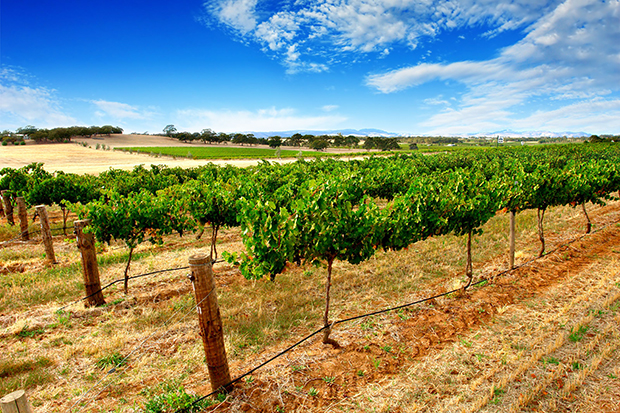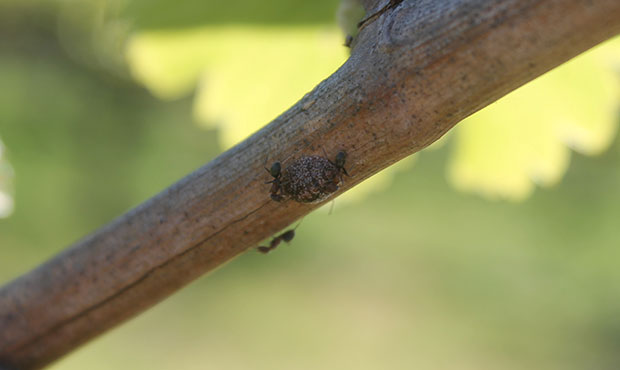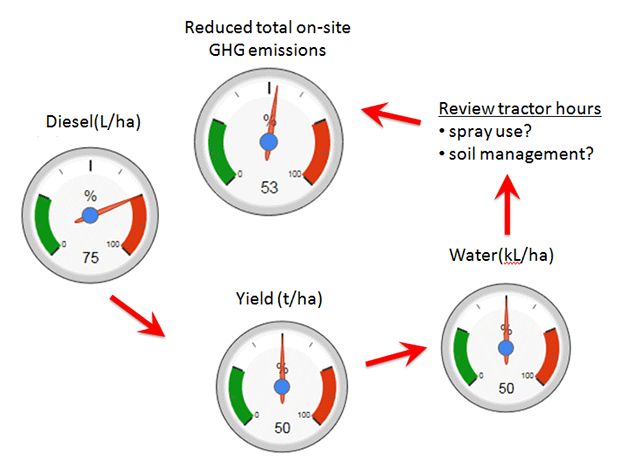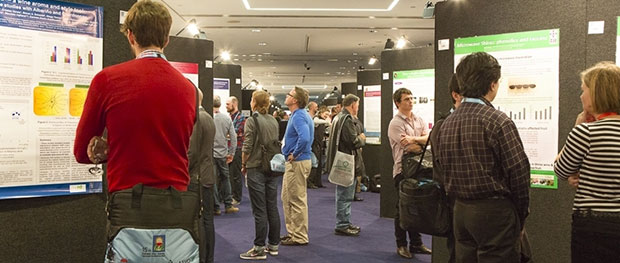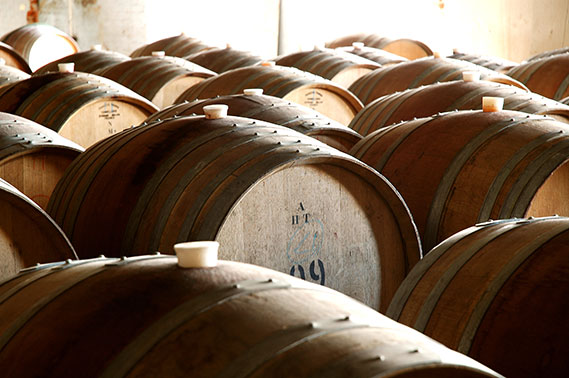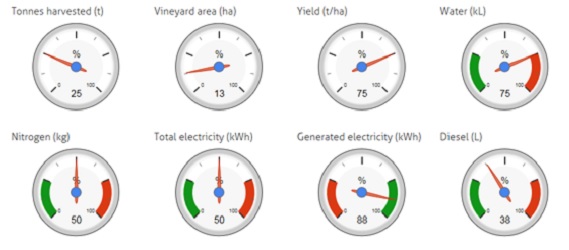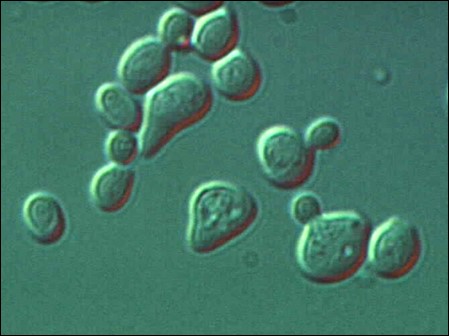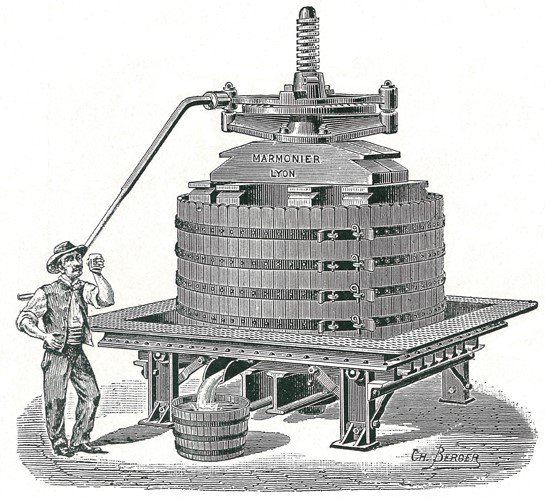Order the latest AWRI staff publications online
Accessing the latest AWRI publications is easy. Visit the AWRI Publications web page to:
- View the 10 most recent AWRI staff publications and order the articles online from the AWRI Library
- Search the staff publications database
- Read the full-text of ‘Technical Notes’ from Technical Review (PDF format)
- Read the full-text of ‘AWRI reports’ published in Wine & Viticulture Journal (PDF format).
A full list of AWRI publications published since the last eNews is included below.
1753 Ward, S.C., Petrie, P.R., Johnson, T.E., Boss, P.K., Bastian, S.E.P. Unripe berries and petioles in Vitis Vinifera cv. Cabernet Sauvignon fermentations affect sensory and chemical profiles. Am. J. Enol. Vitic. 66 (4): 435-443; 2015.
1754 Hixson, J.L., Bindon, K.A., Smith, P.A. Evaluation of direct phloroglucinolysis and colorimetric depolymerization assays and their applicability for determining condensed tannins in grape marc. J. Agric. Food Chem. DOI: 10.1021/acs.jafc.5b04207: 31 p.; 2015.
1755 Krstic, M.R., Johnson, D.L., Herderich, M.J. Review of smoke taint in wine: smoke-derived volatile phenols and their glycosidic metabolites in grapes and vines as biomarkers for smoke exposure and their role in the sensory perception of smoke taint. Aust. J. Grape Wine Res. 21 (S1): 537-553; 2015.
1756 Smith, P.A., McRae, J.M., Bindon, K.A. Impact of winemaking practices on the concentration and composition of tannins in red wine. Aust. J. Grape Wine Res. 21 (S1): 601-614; 2015.
1757 Chambers, P.J., Borneman, A.R., Varela, C., Cordente, A.G., Bellon, J.R., Tran, T.M.T., Henschke, P.A., Curtin, C.D. Ongoing domestication of wine yeast: past, present and future. Aust. J. Grape Wine Res. 21 (S1): 642-650; 2015.
1758 Bekker, M.Z., Day, M.P., Holt, H., Wilkes, E., Smith, P.A. Effect of oxygen exposure during fermentation on volatile sulfur compounds in Shiraz wine and a comparison of strategies for remediation of reductive character. Aust. J. Grape Wine Res. DOI: 10.1111/ajgw.12172: 12 p.; 2015.
1759 Bartowsky, E.J., Costello, P.J., Chambers, P.J. Emerging trends in the application of malolactic fermentation. Aust. J. Grape Wine Res. 21 (S1): 663-669; 2015.
1760 Higginson, E.G., Lloyd, N.D.R., Kravchuk, O., Ford, C.M., Thomas, M.R. A high-throughput UHPLC MS/MS method for evaluation of tartaric and malic acid concentration in individual grapevine berries. Aust. J. Grape Wine Res. DOI: 10.1111/ajgw.12170: 8 p.; 2015.
1761 Longbottom, M. Ask the AWRI: Nitrous oxide and viticulture. Aust. N.Z. Grapegrower Winemaker (621): 42-43; 2015.
1762 Scrimgeour, N. Ferment sensor technologies put through their paces. Aust. N.Z. Grapegrower Winemaker (621): 68, 70, 72-74; 2015.
1763 Coulter, A. Ask the AWRI: Spoilage due to lactic acid bacteria. Aust. N.Z. Grapegrower Winemaker (622): 76-77; 2015.
1764 Coulter, A.D., Holdstock, M.G., Cowey, G.D., Simos, C.A., Smith, P.A., Wilkes, E.N. Potassium bitartrate crystallisation in wine and its inhibition. Aust. J. Grape Wine Res. 21 (S1): 627-641; 2015.
1765 Mierczynska-Vasilev, A., Smith, P.A. Current state of knowledge and challenges in wine clarification. Aust. J. Grape Wine Res. 21 (S1): 615-626; 2015.
1766 Curtin, C., Varela, C., Borneman, A. Harnessing improved understanding of Brettanomyces bruxellensis biology to mitigate the risk of wine spoilage. Aust. J. Grape Wine Res. 21 (S1): 680-692; 2015.
1767 Schmidt, S.A., Henschke, P.A. Production, reactivation and nutrient requirements of active dried yeast in winemaking: theory and practice. Aust. J. Grape Wine Res. 21 (S1): 651-662; 2015.
1768 Godden, P., Wilkes, E., Johnson, D. Trends in the composition of Australian wine 1984-2014. Aust. J. Grape Wine Res. 21 (S1): 741-753; 2015.
1769 Varela, C., Dry, P.R., Kutyna, D.R., Francis, I.L., Henschke, P.A., Curtin, C.D., Chambers, P.J. Strategies for reducing alcohol concentration in wine. Aust. J. Grape Wine Res. 21 (S1): 670-679; 2015.
1770 Longbottom, M.L., Petrie, P.R. Role of vineyard practices in generating and mitigating greenhouse gas emissions. Aust. J. Grape Wine Res. 21 (S1): 522-536; 2015.
1771 Herderich, M., Barter, S., Black, C.A., Bramley, R., Capone, D., Dry, P., Siebert, T., Zhang, P. Terroir effects on grape and wine aroma compounds. Ebeler, S.B., Sacks, G., Vidal, S., Winterhalter, P. (eds.) Advances in wine research. Washington, D.C: American Chemical Society: 131–146; 2015. (ACS Symposium series; 1203).
1772 Longbottom, M. A successful seminar and awards night. Wine Vitic. J. 30 (6): p. 10; 2015.
1773 Gawel, R., Day, M., Schulkin, A., Smith, P. Murky winemaking: How juice solids affect the macromolecular composition and mouthfeel of white wine. Wine Vitic. J. 30 (6): 18-22; 2015.
1774 Smith, P., Schulkin, A., Kassara, S., Barter, S., Solomon, M., Cynkar, W., Capone, D., Francis, L., Bindon, K., Johnson, D. Applying the latest understanding of grape composition. Wine Vitic. J. 30 (6): 33-36, 38; 2015.
1775 Dry, P. Friulano. Wine Vitic. J. 30 (6): p. 54; 2015.
1776 Essling, M. Ask the AWRI: Skipping vineyard sprays in dry years. Aust. N.Z. Grapegrower Winemaker (623): p. 38; 2015.
1777 Johnson, D. 2015 Report: Implementation and execution. Aust. N.Z. Grapegrower Winemaker (623): 67-70; 2015.
1778 Lloyd, N., Johnson, D.L., Herderich, M.J. Metabolomics approaches for resolving and harnessing chemical diversity in grapes., yeast and wine. Aust. J. Grape Wine Res. 21 (S1): 723-740; 2015.
1779 Johnson, D.L., Rose, L.E. Foreword to the special edition of the Australian Journal of Grape and Wine Research celebrating the 60th anniversary of The Australian Wine Research Institute. Aust. J. Grape Wine Res. 21 (S1): p. 521; 2015.
1780 Black, C.A., Parker, M., Siebert, T.E., Capone, D.L., Francis, I.L. Terpenoids and their role in wine flavour: recent advances. Aust. J. Grape Wine Res. 21 (S1): 582-600; 2015.
1781 Day, M.P., Schmidt, S.A., Smith, P.A., Wilkes, E.N. Use and impact of oxygen during winemaking. Aust. J. Grape Wine Res. 21 (S1): 693-704; 2015.
1782 Smith, M.E., Bekker, M.Z., Smith, P.A., Wilkes, E.N. Sources of volatile sulfur compounds in wine. Aust. J. Grape Wine Res. 21 (S1): 705-712; 2015.
1783 Scrimgeour, N., Nordestgaard, S., Lloyd, N.D.R., Wilkes, E.N. Exploring the effect of elevated storage temperature on wine composition. Aust. J. Grape Wine Res. 21 (S1): 713-722; 2015.
1784 Dry, P. Marzemino. Wine Vitic. J. 28 (4): p. 63; 2013.
1785 Bindon, K.A., Carew, A.L., Mierczynska-Vasilev, A., Kassara, S., Kerslake, F., Smith, P.A. Characterization of macromolecular complexes in red wine: composition, molecular mass distribution and particle size. Food Chem. 199: 838-846; 2016.
1786 Sparrow, A.M., Holt, H.E., Pearson, W., Dambergs, R.G., Close, D.C. Accentuated cut edges (ACE): effects of skin fragmentation on the composition and sensory attributes of Pinot noir wines. Am. J. Enol. Vitic. DOI: 10.5344/ajev.2015.15094: 32 p.; 2016.
1787 Holdstock, M. Ask the AWRI: All things analysis. Aust. N.Z. Grapegrower Winemaker (624): 52-53; 2016.
1788 Wilkes, E. Baume to alcohol: It’s only an approximation. Aust. N.Z. Grapegrower Winemaker (624): 59-61; 2016.
1789 Nordestgaard, S. SIMEI 2015 – Wine, olive oil and decanters. Aust. N.Z. Grapegrower Winemaker (624): 66-68; 2016. |


